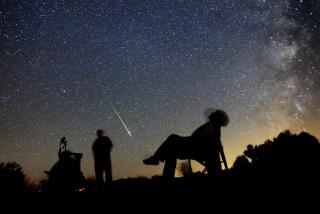Agony and Ecstasy of Watching Weather : Meteorology: Observers deal with long hours and poor pay to note the conditions.
- Share via
Eighty-year-old Edna Cooley has been waking up at 3 a.m. for nearly 22 years to trudge outside in occasional bone-chilling cold and record the weather in rural Austin, Nev., sometimes shoveling snow out of her way as she goes.
About 18 1/2 hours later at 9:30 p.m., Cooley makes the last of her six daily weather observations and temperature recordings for the National Weather Service, earning $11.10 each day for her troubles.
“Why do I keep doing it? They say you can even get used to hanging if you hang long enough,” Cooley said of the sometimes thankless job. “I’ve been meaning to quit for two years, but can’t find anyone else to do this.
“Of course, I take vacations sometimes, maybe even for three weeks or a month, and so there’s no weather coming out of Austin. The TV stations just say, ‘Oh well, I guess that Edna’s out of town again.’ ”
Cooley, Debi Gill of Wildhorse Reservoir and Susan Deming of Battle Mountain are three of a handful of National Weather Service observers in Nevada and among the last of a dying breed of hands-on recorders of the nation’s physical highs, lows and precipitation amounts.
The work is tedious and includes early-morning and late-night hours with regular routines to be done in between, all for very little pay. But without the observers, meteorologists and forecasters would have a more difficult time predicting the nation’s weather.
“There’s a need for live observation,” said Gerald Miles, a meteorologist in Elko who supervises the weather watchers. “Equipment is reliable, but you need good remarks from observers to go with it. Equipment has its limitations.”
Cooley said she copes with the demanding observation schedule by taking catnaps when possible, especially around midday, after her 11:30 a.m. readings and before the afternoon and evening routine begins.
“Sometimes I dream about the weather, like the other night. I thought it was snowing, but when I woke up, it was dry as a bone,” she said.
Debi Gill, who usually reports Nevada’s coldest overnight lows at Wildhorse Reservoir, just south of the Idaho border, said she has been an observer for the last 3 1/2 years while her husband, Pete, supervises the park.
“When it gets really cold, I go out with two pairs of sweats on, two sweaters, hat, gloves; I look like a snow bunny out there,” she said. “Sometimes, I wonder why I keep doing it, especially at 5:30 in the morning.”
Gill, like other weather observers, gets $2.50 for the first early-morning recording, $1.60 for daytime readings and $1.90 for each night observation.
For Gill, that’s $15.90 a day to be split with Dolly Rinbey, the wife of the local game warden who shares the nine daily weather observations at Wildhorse Reservoir, 66 miles north of Elko.
“It’s tough sometimes because it can be clear as a bell everywhere else but storming like mad here,” Gill said. “We have our own ecosystem, and there’s no rhyme or reason to it.”
Whiteout storms have prevented Gill from making observation on a few occasions, but the most frightening thing about the job is the late-night readings taken when near-silence fuels the imagination, she said.
“When the lake is frozen over, the ice groans and the coyotes are yipping and howling, I just get all nervous,” said Gill, who has four children, ages 13 to just under 2 years old. “It’s silly, but I get scared of the Boogeyman because that’s the only one who would be out that time of night.”
The good part of the job is closely watching how nature works and stopping to enjoy the surrounding weather, sunrises and sunsets, she said.
“Not many people stop and watch the sky,” she said. “The clouds actually grow, puff up right before your eyes. It’s wonderful.”
Susan Deming, who has been observing the weather in Battle Mountain since May, starts at 8:30 a.m. and makes hourly readings until 6:30 p.m.. Her husband just built an addition to their home to hold the weather-observation equipment, including temperature graphs and charts.
“I do it for the extra money, and it is interesting work,” she said. “My youngest son is doing a science project on clouds because he knew I’d be able to help him. Observing the weather is more complicated than it looks.”
There are three layers of clouds with nine different basic cloud types possible at each level, according to the weather observers. Precipitation from snowfall is measured by melting what accumulates in a barrel.
“It’s time-consuming sometimes, and I get tired of it,” Deming said. “But I guess I’ll stick with it for a while since we just built this building for my equipment.”
Deming said people sometimes stop her on the street or telephone her asking what the weather will be like or other weather-related questions, such as whether they should store items yet or whether it’s too soon to plant.
“I have to tell them I don’t predict the weather; I just observe it,” she said.
More to Read
Sign up for Essential California
The most important California stories and recommendations in your inbox every morning.
You may occasionally receive promotional content from the Los Angeles Times.













